Dostoiévski disse uma vez: “Muita infelicidade veio ao mundo por causa de confusões e coisas não ditas”. Porém, a falta de comunicação pode trazer muito mais do que um simples momento de infelicidade.
Porém, a falta de comunicação pode trazer muito mais do que um simples momento de infelicidade.
Embora Dostoiévski (provavelmente) não tenha pensado na comunicação em equipe ao escrever sua famosa frase, a falta de comunicação ou a má comunicação podem levar à completa desintegração de uma equipe.
A comunicação é importante porque quando os membros da equipe não se comunicam bem durante o trabalho conjunto, eles não conseguem colaborar com sucesso.
Neste guia, vamos entrar em detalhes sobre a comunicação de equipe e sua importância, e abordaremos tópicos como:
- A definição básica de comunicação em equipe
- Os benefícios de uma boa comunicação em equipe
- Como a má comunicação afeta uma equipe
Também compartilharemos algumas informações de especialistas e dicas sobre como se comunicar de maneira eficaz em equipe.
Vamos dar uma olhada!

O que é comunicação em equipe?
De acordo com o site MIT Human Resources uma equipe é um grupo “deliberadamente e cuidadosamente formado para atender às necessidades de trabalho que não podem ser atendidas de forma tão eficaz por um indivíduo ou grupo de indivíduos”.
O mesmo site define o trabalho em equipe como “um compromisso compartilhado tanto com o processo da equipe (como a equipe trabalha em conjunto) quanto com seu produto (que trabalho a equipe realizou)”.
Para realizar o trabalho em equipe, os indivíduos precisam trabalhar de forma independente, mas também se reunir regularmente para:
- Tomar decisões
- Realizar discussões
- Planejar o trabalho futuro
- Resolver problemas
Para realizar essas ações, a equipe precisa se comunicar de forma regular e eficaz.
Team communication: Definition
A comunicação da equipe representa todas as interações e trocas de informações que ocorrem em uma equipe. Isso inclui vários itens:
- Tipos de comunicação (por exemplo, comunicação verbal, comunicação não verbal, comunicação escrita ou interações visuais)
- Situações de comunicação (por exemplo, conversas individuais, entrevistas de emprego ou reuniões)
- Estilos de comunicação (por exemplo, comunicação agressiva, passiva ou assertiva)
- Canais de comunicação (por exemplo, chamadas telefônicas, mensagens diretas em aplicativos de comunicação para equipes ou e-mails)
- Modelos de comunicação (por exemplo, comunicação unidirecional, bidirecional e comunicação bidirecional complexa)
Em sua essência, a comunicação em equipe é a transmissão de informações.
Para termos uma comunicação em equipe seja verdadeiramente eficaz é necessário que a informação tenha sucesso, ou seja, a pessoa que compartilha a informação deve comunicá-la corretamente, e a pessoa ou o grupo que a recebe deve interpretá-la de forma adequada.
Os componentes da comunicação
Para melhorar a comunicação em equipe, é importante entender a fundo o processo de comunicação.
De acordo com diversos modelos teóricos, o processo de comunicação é uma série de ações realizadas para transmitir uma mensagem com sucesso. Ele envolve 8 componentes principais:
- O emissor (quem inicia a comunicação)
- A mensagem (uma informação, pensamento ou ideia transmitida a outros)
- A codificação (o processo de transformar um pensamento ou ideia em comunicação)
- O ruído (qualquer fator que interfira e distorça a mensagem pretendida)
- O canal (o meio pelo qual a mensagem viaja do emissor até o receptor)
- O receptor (quem recebe e interpreta a mensagem)
- A decodificação (o processo de compreender os pensamentos e ideias comunicados)
- O feedback (a resposta do receptor à mensagem, que indica se a mensagem foi devidamente codificada, enviada, decodificada e interpretada)
Além disso, a mensagem é moldada pelo ambiente e pelo contexto em que ocorre.
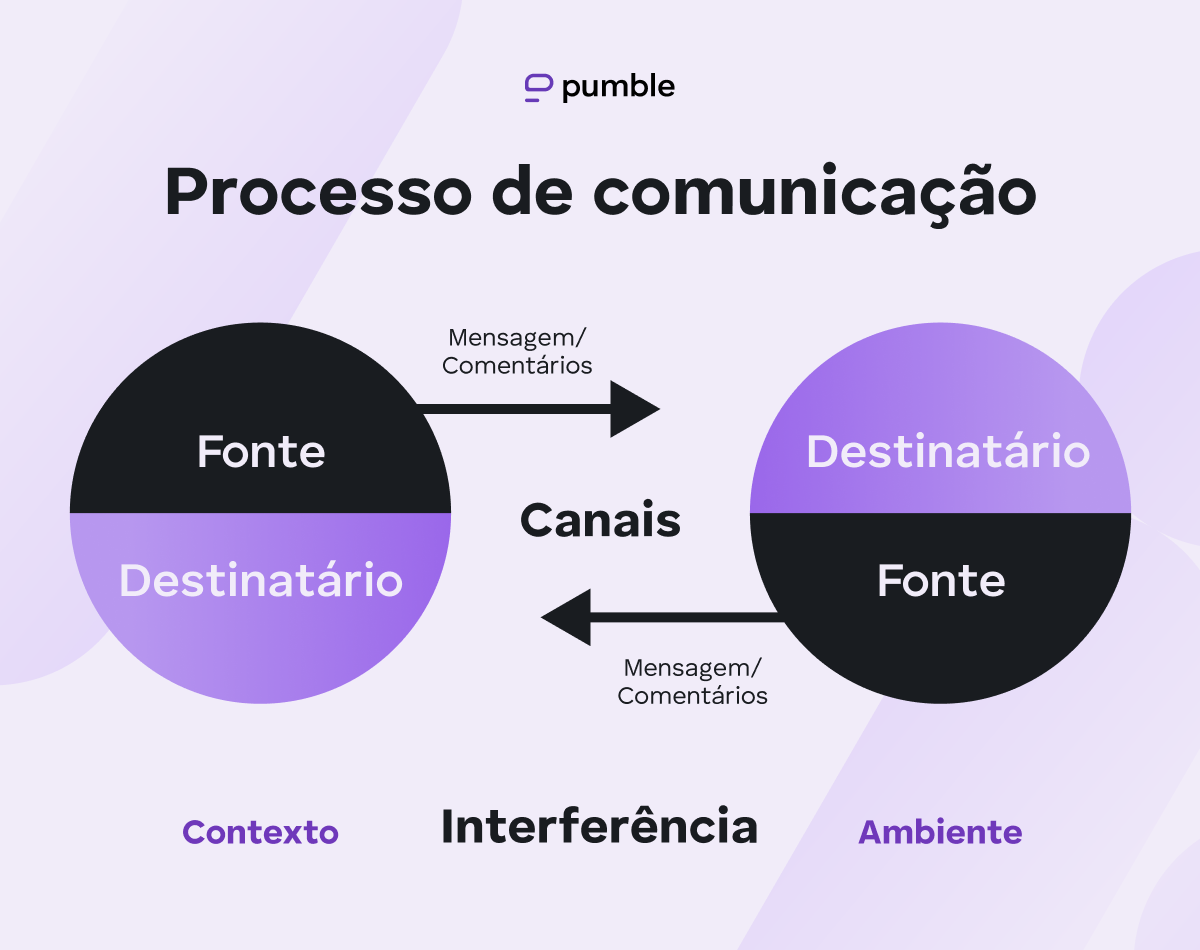
Como a comunicação em equipe influencia o trabalho em equipe
A comunicação é um elemento crucial para estabelecer um bom trabalho em equipe no espaço de trabalho.
O fluxo de novas ideias, o reconhecimento pelos esforços realizados até o momento, o feedback que o inspira a melhorar ainda mais ou, em essência, todos os benefícios que advêm do trabalho em equipe, exigem uma comunicação constante e adequada.
Discutimos esse assunto com o Dr. Raffaello Antonino, professor de aconselhamento psicológico, que concorda que a comunicação em equipe influencia todos os aspectos do trabalho em equipe.

“Pense na comunicação da equipe como a cola que mantém toda a organização unida. Ela afeta diretamente o funcionamento de uma equipe. A comunicação eficaz garante que o cargo de trabalho seja partilhado igualmente, para promover um sentimento de unidade e propósito comum. Elimine a confusão descrevendo claramente o papel e as responsabilidades de todos, aumentando a produtividade e o foco. É também a ferramenta mais poderosa em:
- Resolução de conflitos
- Difusão de estresse
- Promoção da compreensão
O Dr. Antonino também acrescentou que a comunicação influencia a dinâmica da equipe em todos os níveis:”

“E não esqueçamos que é através de conversas casuais e risadas compartilhadas que se formam laços fortes, tornando o local de trabalho um ambiente agradável. Em essência, a comunicação da equipe é o maestro dos bastidores do trabalho em equipe, influenciando a dinâmica de todos de uma forma sutil, mas significativa.”
O especialista em comunicação e relações públicas, Jake Ciccarelli, concorda e acrescenta que existem 3 pontos principais na relação entre comunicação e trabalho em equipe.

“A comunicação está relacionada ao trabalho em equipe de três maneiras principais:
Compartilhar informações — A comunicação permite que a equipe veja se todos estão alinhados quanto a uma tarefa ou projeto, além de fornecer a todos os membros as informações apropriadas e necessárias.
Construir confiança mútua — A confiança vem de saber que vocês podem contar uns com os outros quando as coisas ficam difíceis.
Aumentar a produtividade — A comunicação aberta faz com que os membros da equipe se sintam mais à vontade para se expressar no ambiente compartilhado. Quanto mais confortável a pessoa se sente, maior a chance de ela comunicar possíveis problemas, o que facilita o sucesso.”
Vamos agora analisar outros aspectos que comprovam a importância da comunicação em equipe.
Benefícios da comunicação em equipe
Como já vimos, uma comunicação empresarial eficaz é de extrema importância porque o trabalho em equipe depende dela.
No entanto, o trabalho em equipe traz uma infinidade de benefícios, como:
- Gera grandes ideias — De acordo com John J. Murphy, autor de “Pulling Together: 10 Rules for High-Performance Teamwork”, podemos admirar “gênios solitários”, mas cada nome famoso cujas invenções e habilidades elogiamos hoje tinha um grupo de pessoas por trás deles que tornaram tudo possível até certo ponto.
- Incentiva a tomada de riscos saudáveis — Trabalhar em equipe permite que os indivíduos compartilhem a responsabilidade com seus colegas de equipe e, assim, os incentiva a assumir riscos saudáveis. Isso é benéfico tanto para os funcionários (pois os ajuda a serem percebidos de forma mais favorável) quanto para as organizações (pois permite que os trabalhadores proponham novas soluções para problemas antigos).
- Torna os indivíduos mais felizes (e mais bem-sucedidos) — Uma pesquisa da Atlassian relata que feedback honesto, respeito mútuo e abertura pessoal (que são essenciais para um ótimo trabalho em equipe) ajudam a tornar os membros de uma equipe 80% mais propensos a relatar alto bem-estar emocional e 60% mais propensos a realizar mais e executar o trabalho mais rapidamente.
- Ajuda os colegas de equipe a crescerem como indivíduos — O trabalho em equipe pode ajudar os indivíduos a compreenderem suas fraquezas e, então, trabalharem para melhorá-las. Além disso, trabalhar em equipe significa ter um espaço seguro para crescer, com o apoio de outros membros da equipe (por meio de delegação, feedback, etc.).
- Diminui a chance de burnout — De acordo com um estudo realizado pela Edelman Data and Intelligence, 50% dos funcionários e 53% dos gerentes já experimentaram pelo menos algum nível de burnout. O burnout está associado ao estresse de ter muito trabalho para fazer e não ter tempo e recursos suficientes para fazê-lo. O trabalho em equipe pode aliviar esse tipo de estresse, pois as equipes compartilham a carga de trabalho.
Além disso, um estudo de 2021 feito sobre trabalho em equipe e tomada de decisão em equipe mostrou que as equipes tendem a chegar a conclusões por meio da troca de argumentos e comunicação, o que leva a:
- Melhor desempenho do grupo
- Melhor compreensão
- Colaboração mais fácil
- Aumento da produtividade
- Maior criatividade
- Solução de problemas mais eficiente
- Menor chance de conflitos
Por outro lado, uma comunicação ruim traz efeitos negativos consideráveis para a maioria das equipes.
Consequências da má comunicação em equipe
A má comunicação acontece quando o remetente e o destinatário têm visões diferentes sobre a mensagem. Isso pode acontecer por vários motivos, mas os efeitos são sempre os mesmos — falta de comunicação.
Nas equipes, esse problema pode ocorrer na interação individual entre os membros da equipe, entre gestores e funcionários, bem como dentro da equipe como um todo.
Os efeitos da má comunicação prolongada nas equipes podem ser graves:
- Ambiente de trabalho instável
- Diminuição da produtividade
- Interrupção na colaboração
- Baixa moral
- Tensão no local de trabalho
- Conflito
- Relações externas ruinse
- Perda de reputação
Vamos aprender mais sobre cada consequência da falta de comunicação.
Consequência #1: Ambiente de trabalho instável
Quando as equipes não conseguem se comunicar de forma eficaz, ficam facilmente sobrecarregadas pela incerteza e pelo estresse constantes de não terem objetivos claros.
E, como mencionamos anteriormente, funcionários que não sabem o que se espera deles têm menos motivação para realizar as suas tarefas.
Consequência #2: Produtividade reduzida
Quando há uma quebra na comunicação, os membros da equipe não conseguem trabalhar em seu nível máximo. O que resulta em uma queda no engajamento dos funcionários na equipe.
Considerando que 88% dos funcionários engajados gostam do seu trabalho e 50% deles prosperam na vida pessoal e profissional, fica claro que a má comunicação pode afetar diretamente sua produtividade.
Consequência #3: Interrupções na colaboração da equipe
Sem uma comunicação eficaz, os membros da equipe muitas vezes ficam sozinhos e incapazes de colaborar adequadamente. Isto, por sua vez, fecha a porta à inovação, a discussão de ideias e a muitas outras formas de trabalho colaborativo.
Consequência #4: Baixa moral dos funcionários
Sem comunicação adequada, os funcionários podem se sentir subestimados, o que leva a uma queda no desempenho. Quando os funcionários estão desmotivados, eles se sentem menos inclinados a usar suas habilidades para o sucesso da empresa.
🎓 Dica profissional do Pumble
Se você está procurando maneiras de aumentar a satisfação e a produtividade no seu local de trabalho, confira o nosso guia:
Consequência #5: Tensão e conflitos no espaço de trabalho
Em um ambiente de incerteza e falta de comunicação, a tensão pode aumentar e atrapalhar o fluxo de trabalho. O efeito mais visível, e ao mesmo tempo mais prejudicial, da má comunicação é o conflito entre colegas de trabalho, que pode prejudicar toda a equipe.
🎓 Dica profissional do Pumble
Se você precisa de ajuda para lidar com tensões e discussões no trabalho, confira nossas dicas de especialistas:
Consequência #6: Má comunicação causa maus relacionamentos externos
A má comunicação é contagiosa, por isso, quando os membros da equipe não se comunicam bem, podem enviar mensagens confusas e até contraditórias aos clientes e outras partes externas.
Quando a má comunicação se torna um padrão, toda a empresa sofre — com o acúmulo de avaliações negativas, a reputação da organização é seriamente afetada.
Dicas para melhorar a comunicação dentro de uma equipe
De acordo com a pesquisa Estatísticas de Comunicação no Trabalho em 2025, do Pumble, 40% dos líderes empresariais afirmam que a má comunicação reduz a produtividade, e 32% relatam ter notado o impacto financeiro causado por essa falha.
É por isso que adquirir fortes habilidades de comunicação em equipe pode fazer maravilhas para você e seus colegas de trabalho. Mas qual abordagem exata você pode adotar para alcançar uma comunicação em grupo eficaz?
Vamos conferir algumas dicas práticas.
Dica 1: Seja honesto
Honestidade e comunicação aberta são os pilares de uma equipe bem-sucedida.
No entanto, muitas vezes as pessoas optam por se conformar no trabalho por medo de ir contra a maioria. Mas a verdade é que a falta de autenticidade no trabalho cria uma dissonância interna que faz com que o indivíduo se distancie do resto da equipe.
Além disso, quando um membro da equipe expressa desacordo com a ideia geral, isso proporciona uma perspectiva diferente que pode beneficiar a todos.
Por exemplo, digamos que um membro da equipe de marketing foi o único que percebeu que o novo slogan poderia ser mal interpretado. Se essa pessoa decidir ficar calada porque os demais concordam que o slogan é bom, isso poderá prejudicar seriamente a marca.
Entretanto, a comunicação honesta não significa que você deva ser direto e dizer tudo o que pensa de maneira rude ou agressiva.
Ainda assim, a comunicação honesta não significa que você deva dizer de maneira direta e rude tudo o que está em sua mente. Manter uma comunicação positiva enquanto ser honesto é de extrema importância porque constrói relacionamentos entre equipes e aumenta a motivação e a produtividade (entre outras coisas).
Dê uma olhada na conversa do Pumble abaixo. Emilia expressa sua forte opinião com clareza, mas, apesar disso, poderia ter formulado a mensagem de forma mais leve — especialmente porque está tentando convencer um grupo de pessoas que concordam entre si.
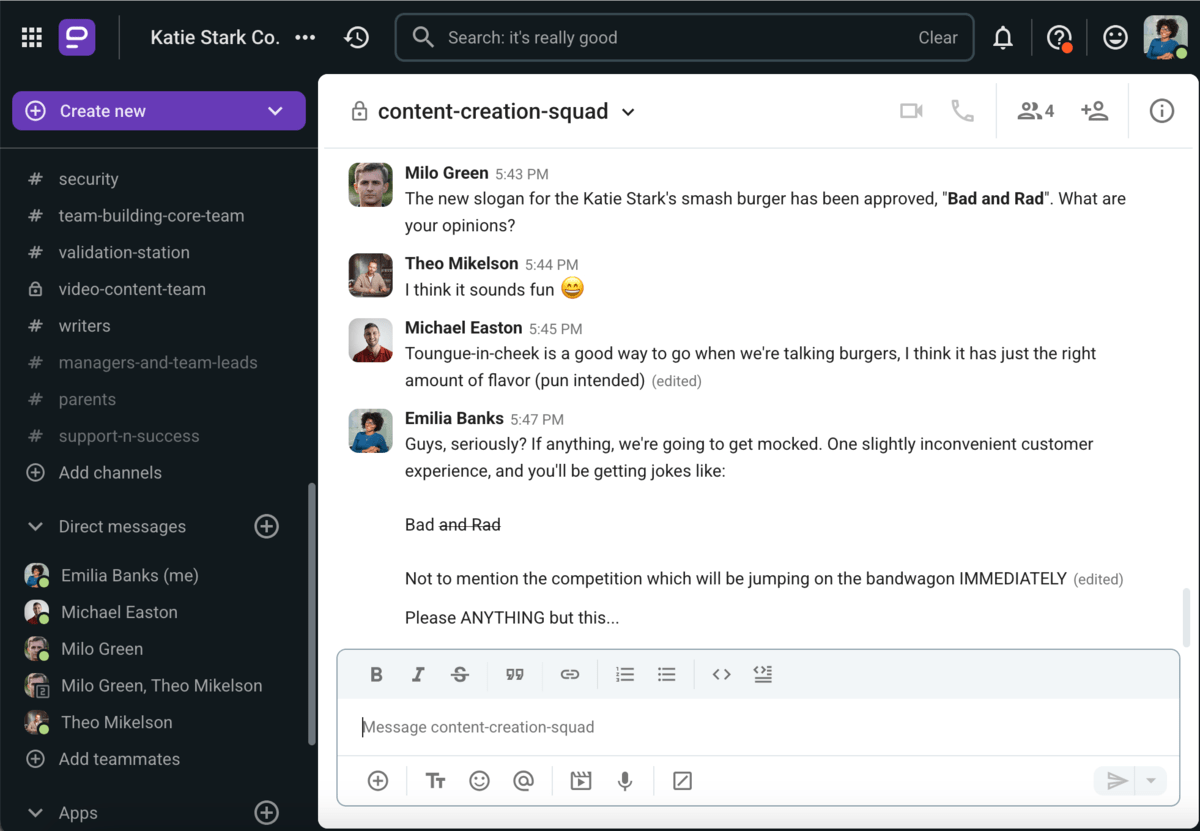
Crie uma dinâmica de equipe positiva com o Pumble
🎓 Dica profissional do Pumble
Ser desonesto e censurar-se na esperança de manter o “status social” é um dos erros de comunicação mais comuns que os funcionários cometem. Descubra quais são os outros 13 erros mais comuns (e como superá-los) na seguinte postagem do blog Pumble:
Dica 2: Seja claro e conciso
Um dos componentes mais importantes da comunicação em equipe é estar disposto a transmitir a mensagem de forma clara e precisa.
Portanto, pense antes de falar e tente transmitir sua ideia da forma mais eficaz possível.
A falta de comunicação clara leva as pessoas a confiar em suposições ao interpretar a mensagem, o que é uma das principais causas do alvo falha na comunicação.
A má comunicação, de modo geral, leva a mal-entendidos, e esses, por sua vez, podem causar vários problemas na equipe, como:
- Prazos perdidos
- Erros
- Gargalos no fluxo de trabalho
- Conflitos
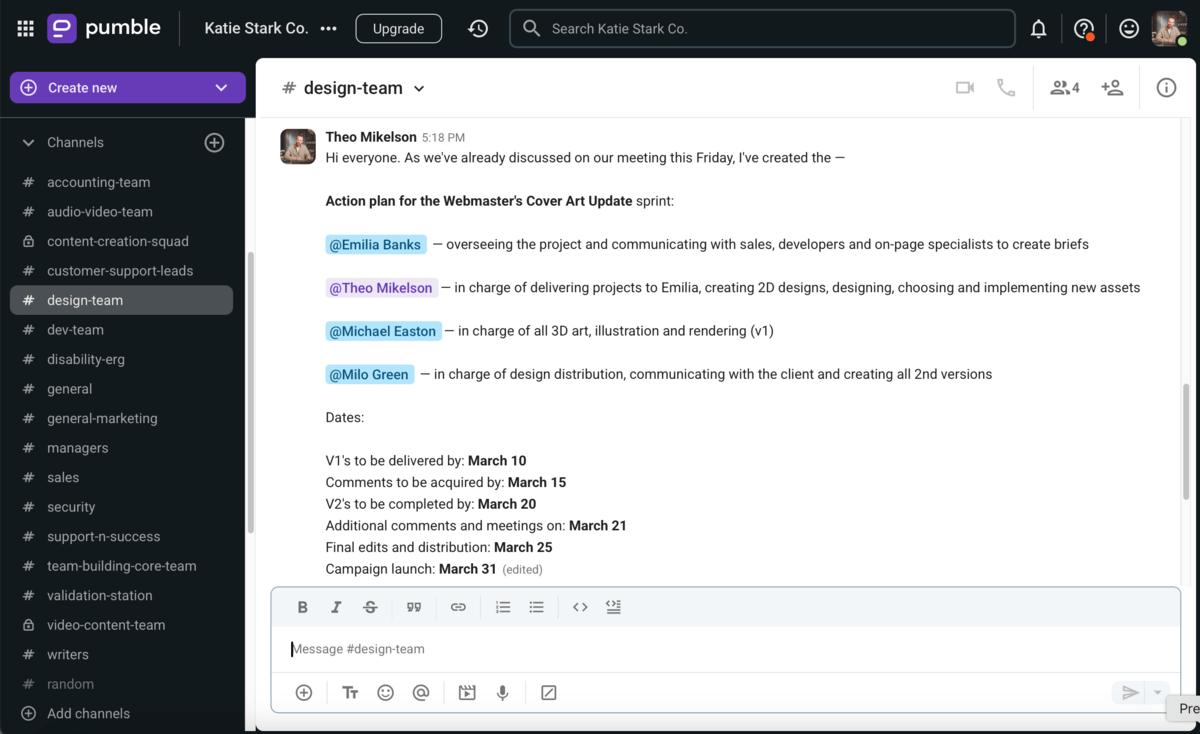
Promova uma comunicação eficaz em equipe com o Pumble
Dica 3: Seja respeitoso e atencioso
Pesquisas sobre comunicação respeitosa no trabalho, apresentadas em um estudo recente, mostraram que as pessoas valorizam o engajamento respeitoso mais do que autonomia, segurança no emprego e alta renda.
Portanto, respeite o tempo e a energia de seus companheiros e tome cuidado para não sobrecarregá-los. Se você quiser delegar uma tarefa a alguém, primeiro verifique se essa pessoa tem tempo e está disposta a fazê-lo. Se alguém está fazendo uma pausa e não faz nada, não significa que esteja disposto a trabalhar.
Ser atencioso também significa oferecer ajuda se alguém estiver com dificuldades ou até mesmo levar uma xícara de chá para um colega estressado.
Coisas aparentemente pequenas podem ajudar muito e realmente fortalecer o relacionamento dentro da equipe.
Dica 4: Use comunicação não violenta (CNV)
A comunicação não violenta é um conceito criado por Marshall Rosenberg, Ph.D, apresentado em seu livro Nonviolent Communication: A Language of Life. Este processo inclui:
- Observar sem julgar
- Expressar seus sentimentos
- Expressar suas necessidades
- Expressar seus pedidos
Perguntamos a Avigail Lev, psicoterapeuta, autora, mediadora e coach executiva, quais são os benefícios da CNV. Ela afirma que isso abre muitas possibilidades de comunicação em equipe.

“A Comunicação Não Violenta é uma ferramenta poderosa que promove cenários mutuamente vantajosos para a resolução de problemas. Ela ensina as pessoas a concentrarem-se na identificação de necessidades subjacentes em vez de desejos superficiais, permitindo-nos compreender verdadeiramente o que é importante para cada parte envolvida.
Quando conseguimos distinguir entre desejos e necessidades, podemos participar em negociações que têm maior probabilidade de satisfazer as necessidades fundamentais de todos, promovendo um sentimento de satisfação e cooperação.
Esta abordagem abre a possibilidade de soluções criativas de resolução de problemas que mudam o nosso foco de uma posição rígida para uma exploração flexível de opções que atenda às necessidades subjacentes de todas as partes envolvidas.”
Ela prossegue dizendo que, ao utilizar a CNV, podemos alcançar soluções que muitas vezes são inatingíveis e vantajosas para todos.

“Quando reconhecemos, valorizamos e negociamos diversas necessidades, podemos encontrar cenários vantajosos para todos que promovem a compreensão, a colaboração e resoluções sustentáveis.
A CNV nos ajuda a compreender nossos limites, necessidades e desejos, resultando em uma comunicação mais eficaz e no alcance de soluções em que ambos os lados ganham. Também nos ajuda a desenvolver uma melhor compreensão de nós mesmos, promovendo a autoconsciência e nos permitindo conectar-se com nossas emoções e necessidades.
Essa autoconsciência nos permite transmitir nossos pensamentos e emoções mais autênticas e assertiva
Dica 5: Ouça com atenção
Transmitir sua mensagem com sucesso é apenas parte do trabalho. Uma boa comunicação em equipe também depende da escuta ativa. Esta é uma ferramenta que você pode praticar estando atento ao que seus colegas estão dizendo e compreendendo verdadeiramente o ponto de vista deles.
Para ter certeza de que está fazendo tudo o que pode para ouvir ativamente ao receber uma mensagem, você pode tentar:
- Ajustar sua atitude - Uma atitude positiva torna você mais receptivo ao que as outras pessoas têm a dizer.
- Prestar atenção - Prestar atenção e focar nos sinais verbais e não verbais que as pessoas nos enviam nos torna melhores ouvintes.
- Ajustar sua resposta - Não fazer suposições e ser flexível ao ouvir o que o emissor da mensagem está tentando transmitir também é uma característica importante da escuta ativa.
Dessa forma, você não apenas melhorará a comunicação e colaboração geral da equipe, mas também mostrará respeito pelos outros membros da equipe e por suas opiniões.
🎓 Dica profissional do Pumble
A escuta ativa é uma das ferramentas vitais para uma comunicação eficaz. Para saber mais sobre este tópico, verifique:
Dica 6: Escolha o melhor canal para transmitir sua mensagem
A comunicação eficaz e eficiente também depende do uso inteligente dos diferentes canais de comunicação pela equipe.
Escolher o canal certo para entrar em contato com um colega de trabalho é especialmente importante se você estiver trabalhando em uma equipe remota e não puder simplesmente ir até a mesa dele e fazer uma pergunta.
Mesmo no escritório, a comunicação presencial nem sempre é a melhor opção. Por exemplo, você não irá delegar tarefas de pessoa para pessoa se puder fazê-lo por meio de uma plataforma de gerenciamento de projetos. Da mesma forma, você não ficará parado no meio do escritório gritando um anúncio que precisa entregar a um grupo de pessoas.
Em vez disso, você usará um canal diferente — um que seja uma saída melhor para a comunicação organizacional.
Da mesma forma, mesmo em conversas individuais, quando os trabalhadores remotos precisam consultar seus colegas sobre um problema, é muito mais prático discuti-lo em um aplicativo de comunicação de equipe, como o Pumble, do que enviar e-mails de um lado para outro.
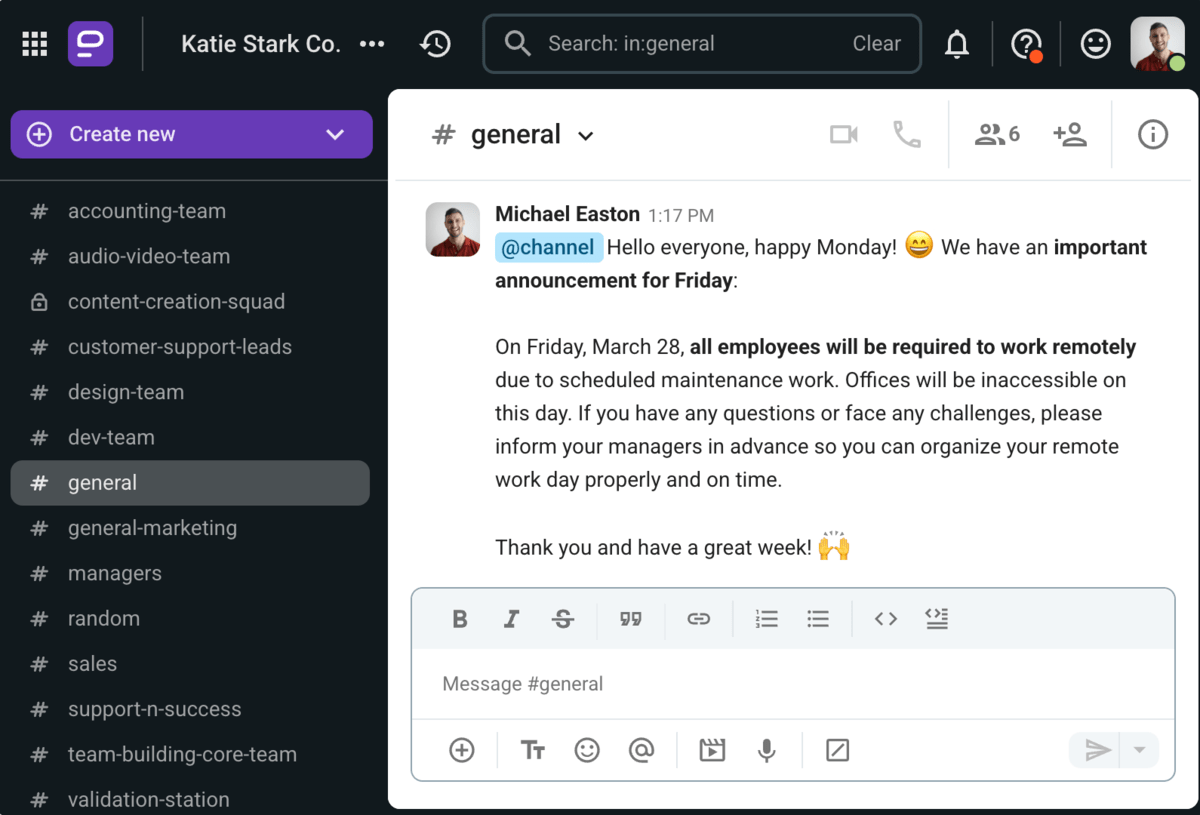
🎓 Dica profissional do Pumble
Manter a comunicação pelos canais certos é uma das melhores maneiras de fazer com que sua equipe remota se sinta conectada. Aqui estão mais dicas de como você pode fazer isso:
Dica 7: Encontre os estilos de comunicação preferidos de todos
Além de encontrar o canal de comunicação que melhor atenda às necessidades de todos, também é crucial que você entenda o estilo de comunicação preferido de cada membro da equipe.
Nem todos se comunicarão da mesma forma (assim como não receberão a mesma mensagem da mesma forma).
Perguntamos o Ciccarelli sobre esse tema e ele afirmou que reconhecer as diferenças na comunicação pode ser a melhor estratégia para melhorar sua eficácia.

“Inicie uma discussão detalhada sobre os estilos de comunicação preferidos de cada membro da equipe. .
Reconhecer que os indivíduos podem ter preferências e desafios únicos quando se trata de comunicação permite que a equipe adapte suas abordagens de acordo. Em particular, alguns membros da equipe podem achar difícil peça ajuda, e é por isso que oferecer assistência de forma proativa, sem esperar por uma solicitação direta, pode ser uma forma eficaz de entrar em contato com eles.
Esta abordagem proativa demonstra apoio e promove um ambiente onde os membros da equipe se sentem confortáveis em pedir ajuda quando precisam.”
Dica 8: Esteja aberto a comentários e críticas construtivas
Ninguém está imune a erros, e muitas vezes não conseguimos enxergar os nossos próprios erros. É por isso que devemos valorizar feedback construtivo vindo de nossos colegas, pois ele pode nos ajudar a aprender, crescer e nos manter engajados.
Críticas construtivas são tão importantes quanto o reconhecimento dos funcionários para melhoria e engajamento, portanto, devemos acolher ambos. Na verdade, qualquer tipo de feedback incentiva o engajamento — ¼ das funcionárias e ⅕ dos funcionários do sexo masculino afirmam que fornecer feedback e reconhecimento é uma ferramenta de envolvimento muito poderosa.
Mesmo que você não concorde com o feedback recebido, aceite-o com elegância e não se sinta ofendido. Simplesmente explique sua perspectiva e tente encontrar um ponto em comum. Onde há espaço para feedback, há espaço para melhorias.
Estar aberto a críticas construtivas significa permitir que os membros de sua equipe o incentivem a sempre se esforçar para melhorar o que faz.
Dica 9: Resolva os problemas à medida que surgirem
Quando não resolvidos, mesmo os pequenos problemas tendem a criar frustrações que eventualmente levam a grandes problemas na equipe. Portanto, se algo estiver incomodando você, comunique-o em um tom respeitoso e neutro e resolva o problema imediatamente.
A comunicação em equipes de trabalho bem-sucedidas funciona bem e não evita lidar com coisas difíceis.
Você pode achar difícil lidar com o problema, mas se abordá-lo imediatamente, você esclarecerá as coisas e evitará o ressentimento.
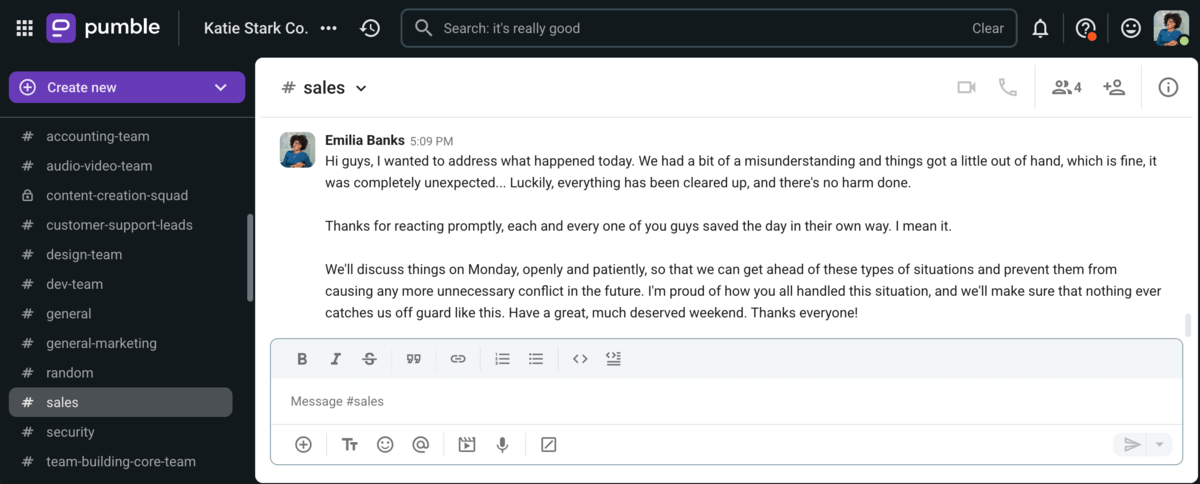
Não deixe nenhum problema ficar sem solução, use o Pumble
Dica 10: Envolva-se em comunicação ascendente
Por fim, certifique-se de que todos os membros da equipe, independentemente de sua posição na hierarquia, sejam incluídos na conversa. Isso é algo que o Dr. Antonino destaca como especialmente importante para o trabalho em equipe e o sucesso geral da equipe.

“Muitas vezes as melhores ideias vêm daqueles que estão na linha de frente, mas podem ser sufocadas pela dinâmica da hierarquia. Incentivar a comunicação desde os níveis mais baixos até os mais altos pode ser uma virada de jogo. “É como abrir a janela e deixar entrar ar fresco no planeamento estratégico, dando a todos um sentido de propriedade e responsabilidade.”
Dr. Antonino também insiste que você se lembre de que a comunicação eficaz da equipe não é uma via de mão única.

"Lembre-se: não se trata apenas de extrair ideias da sua equipe. Trata-se também de promover uma atmosfera de confiança e respeito, onde todos sintam que sua voz importa. E, nem é preciso dizer, os líderes devem estar preparados tanto para feedbacks construtivos quanto para as verdades duras e ocasionais. Como dizem, a verdade pode machucar, mas também pode curar e abrir caminho para o crescimento."
🎓 Dica profissional do Pumble
Claramente, a comunicação é de extrema importância. Se você deseja torná-la ainda melhor, confira estas três postagens:
Amplifique a comunicação interna da equipe com o Pumble
Uma das maneiras mais fáceis de melhorar a comunicação da sua equipe é torná-la simples, acessível e eficaz. Hoje em dia, isso é melhor alcançado com aplicativos de comunicação interna dedicados, como o Pumble.
O Pumble oferece grande versatilidade para diferentes tipos de comunicação, incluindo:
- Comunicação escrita por meio de mensagens diretas e compartilhamento de documentos importantes
- Comunicação verbal por meio de chamadas de voz, mensagens de voz e vídeo e reuniões virtuais
O Pumble funciona como sua sede digital, permitindo flexibilidade na hora de notificar colegas, resolver problemas e desenvolver ideias.
Além disso, o Pumble incentiva uma comunicação mais concisa e eficaz, ajuda a lembrar processos importantes com lembretes personalizados,e facilita o acompanhamento de informações através de threads.
Melhore a comunicação da sua equipe hoje mesmo e comece a aplicar as melhores práticas de forma intuitiva. Experimente o Pumble da CAKE.com!
Como avaliamos esta publicação: Nossos escritores e editores monitoram as postagens e as atualizam quando novas informações ficam disponíveis, para mantê-las atualizadas e relevantes.

